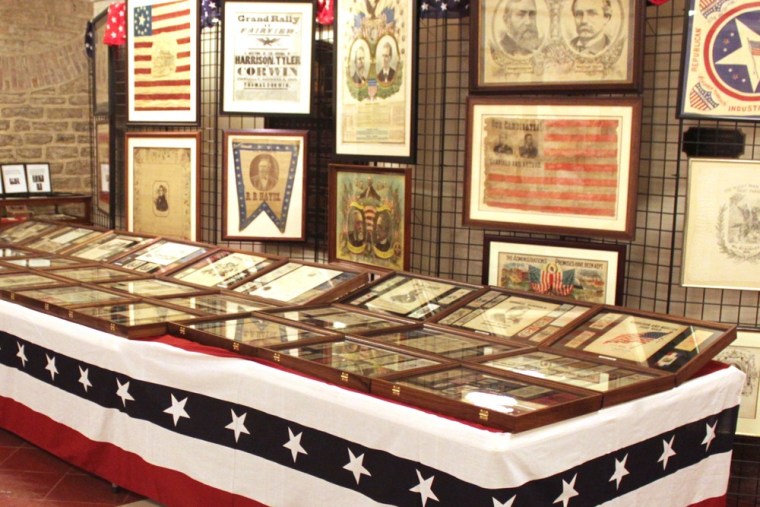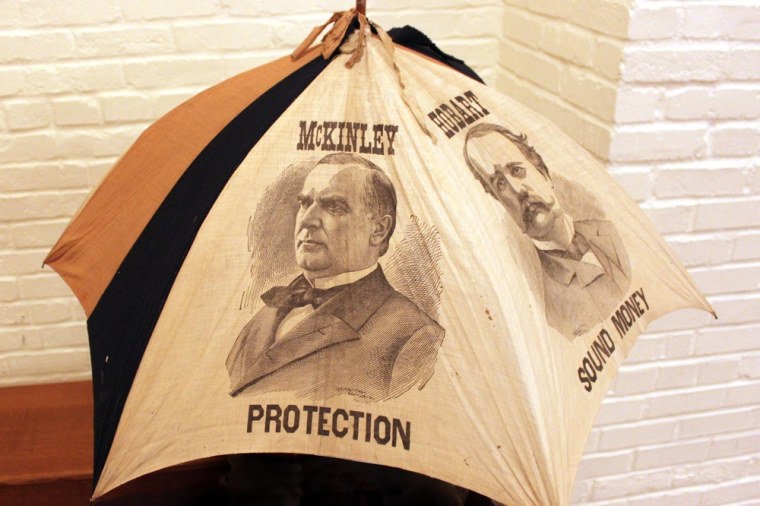
As the Republican and Democratic national conventions gather and the presidential campaigns rev up for the final, raucous push, a quieter perspective can be found amid memorabilia of campaigns past.
Related: Full coverage of the Republican convention
A newly opened exhibit at the Ohio Statehouse in Columbus showcases treasures from the political careers and campaigns of Ohio-born presidents, who all served well before political ads appeared on TV.
It is a “reminder that so many great leaders have come from Ohio,” said Gregg Dodd, deputy director and spokesman for the Ohio Statehouse. The state, often referred to as the "Mother of Presidents," lays claim to eight U.S. presidents: William Henry Harrison, Ulysses Simpson Grant, Rutherford Birchard Hayes, James Abram Garfield, Benjamin Harrison, William McKinley, William Howard Taft and Warren Gamaliel Harding.
“We fight over one with Virginia,” Dodd said. “William Henry Harrison was born in Virginia, but came to Ohio as a very young boy and raised here.” The show is also important, because Ohio, known as the battleground state, “plays an important role in the political process,” he said. “As Ohio votes, so goes the nation.”

Some 46 display cases are filled with campaign buttons, badges, almanacs, glassware, books, textiles, medals, tokens, postcards, pennants, photographs and such novelties as noisemakers. There is even a straight razor and a gunpowder flask.
The items are from the private collection of Ohio-born Mark and Kim Gelke, brothers who began collecting in the1970s. “I grew up with history, and conversation about it was a regular thing at the dinner table,” said Mark Gelke, a retired high school history teacher whose father was a fan of history and whose grandfather collected antique weapons. He is a member of the American Political Items Collectors, a nonprofit organization that is co-sponsoring the exhibit.
Gelke’s interest in political memorabilia was sparked when he fell in love with a cloth banner from Benjamin Harrison’s 1888 campaign at a flea market. He paid $90, quite a sum for a college student in 1977. It was the beginning of the collection that focuses on the 19th century.
Some large items on display include posters, banners and several rare campaign flags. The flags were made illegal by Congress in 1905 because imposing any image on them was considered defacement, said Gelke.
Many of the pieces in the collection reflect how much times have changed, like the delicate and well preserved vintage campaign ribbons. “It’s something you don’t see today,” said Dodd, the Ohio statehouse spokesman. In past eras, he said, ribbons and as well as campaign buttons often bore ample text, with slogans that reflected candidates’ platforms and issues.

An umbrella, too, on display from the 1896 William McKinley campaign, shows the slogans “Protection,” in reference to raising tariffs to protect American industry, and “Sound Money,” which referred to currency inflation, a big issue at the time.
Some treasures have been lost to time, like the very large leather balls inscribed with slogans from the 1840 campaign of William Henry Harrison. “They were rolled from one town to another,” said Gelke. “Can you imagine that?”
In the 1800s, campaigns were frequently focused around large social events that often lasted three to four days, with thousands of people in attendance, during which barbecues, rallies and large parades were held, and campaign songs were sung to promote candidates’ platforms and issues. “Today, collecting sheet music is popular,” he said.
“Campaign parades and rallies are getting to be a thing of the past, as modern campaigns are more focused on technology. And campaign art is getting harder and harder to find,” Gelke said. But meanwhile, “we have fun with it.”
The exhibit is free and open to the public through Sept. 26.
More articles you might like: